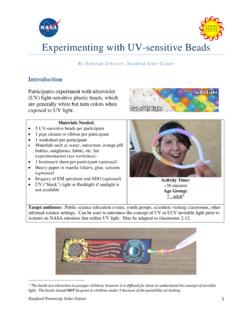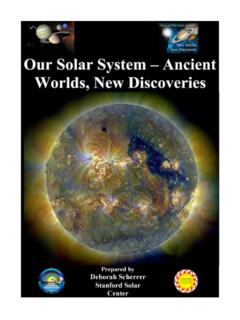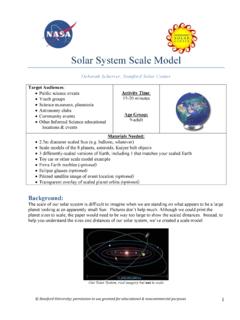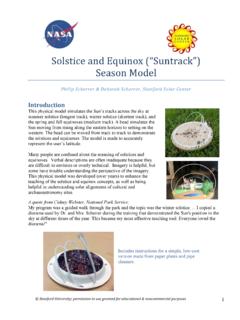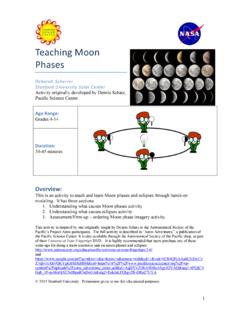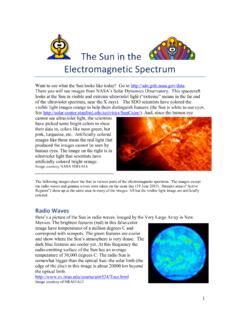Transcription of NASA’s Solar Dynamics Observatory Data in the Classroom
1 NASA's Solar Dynamics Observatory data in the Classroom Scott Hildreth, Shannon Lee, Timothy Dave Chabot Community College, Hayward, CA. A collaborative project between Chabot Community College, the Stanford Solar Center, and NASA's Solar Dynamics Observatory Education and Public Outreach Team. SDO data in the Classroom Table of Contents About the Labs .. 3. The Process of Science .. 3. Introduction .. 3. Our data .. 4. Objectives .. 4. Overview of the Activities .. 4. Part 1: Background Material .. 6. Intro Video: .. 6. Solar Dynamics Observatory Laboratory Quest Worksheet .. 7. Part 2: Directed Introductory Student Activity .. 8. Video 1 Worksheet: .. 9. Video 2 Worksheet: .. 11. Video 3 Worksheet.
2 12. Video 4 Worksheet: .. 13. Video 5 Worksheet: .. 15. Video 6: .. 16. Part 3: Access to Live data .. 17. iSolSearch locates Solar activity and allows you to develop research questions .. 17. Use Helioviewer to generate videos and research your questions .. 20. jHelioviewer goes even 23. Finalization and Summative Assessment .. 26. Student SDO Laboratory Feedback Form .. 27. Additional Resources .. 28. 2. SDO data in the Classroom NASA's Solar Dynamics Observatory data in the Classroom A hands-on laboratory developed by Scott Hildreth, Shannon Lee, Timothy Dave Chabot Community College, Hayward, CA. About the Labs The Process of Science Historically, people tracked and monitored astronomical objects with their eyes.
3 Then telescopes showed us light we could not see with our eyes. Observations originally had to be recorded by making sketches by hand, as Galileo did of the four moons of Jupiter, our Moon, and sunspots on the Sun. More recently we attached cameras to the eyepieces to make photographs. But still, we mostly gathered and analyzed only the visible light from astronomical objects. As technology has advanced we now launch satellites above our atmosphere to observe celestial objects in many wavelengths of light, and collect that light using computerized telescopes that transmit their data digitally back to Earth. We again use computers to analyze the data to do our science investigations. In this activity students will access and use authentic astronomical data , taken recently from NASA's Solar Dynamic Observatory (SDO) spacecraft, to do research on sunspots and Solar activity as part of a collaborative Stanford University, NASA, and Chabot Community College project for citizen science.
4 Introduction There are many stars that dot the night sky but the most important star is the one that we see during the day - our Sun. Most organisms on Earth depend on the Sun for survival. While it is necessary for our existence, the Sun may also be our undoing. Our modern way of life depends on technology, and the more technology-dependent we become the more vulnerable we are to the Sun's outbursts. On March 13 1989, an estimated 6 million people in the region of Quebec Canada lost power for 9. hours. This extensive blackout was caused by the Sun. A massive eruption of plasma, called a coronal mass ejection, had occurred on the Sun and eventually impacted Earth. These eruptions and other Solar activity are actually quite common.
5 We call this connection between Solar activity and its impact on Earth space weather . 3. SDO data in the Classroom Our data NASA's Solar Dynamics Observatory (SDO) -- a Solar space telescope launched in February 2010, circles in geosynchronous orbit about 22,000 miles above the surface of the Earth. SDO includes three scientific instruments: the Atmospheric Imaging Assembly (AIA), the Helioseismic and Magnetic Imager (HMI), and the Extreme-ultraviolet Variability Experiment (EVE). For this lab we will be using authentic, near-real-time data from SDO's AIA and HMI instruments to observe sunspots, flares, Solar eruptions, and other forms of Solar activity. SDO - AIA - HMI - EVE - Objectives From this laboratory, students will be able to: Create movies using real data from AIA and HMI to observe sunspots and Solar flares.
6 Explore the connection between Solar activity and space weather. Use different types of data to generate and test a hypothesis about Solar activity. Collaborate with other students to explore data and their hypotheses. Present their results in a scientifically appropriate manner. Overview of the Activities The laboratory requires access to the internet and is expected to cover at least 2 lab periods of 3. hours each. The process includes: 1. Students observe an online video, Journey to the Sun, produced by KQED Quest in conjunction with the SDO mission team. As the students watch the video, they answer questions about the SDO mission and its data . 2. To begin their research, students view a series of 6 short videos of actual Solar activity, extracted from SDO data .
7 Students again answer questions as they observe the various 4. SDO data in the Classroom forms of flares, prominences, coronal mass ejections, and other forms of Solar activity they encounter. 3. Students go to the online database of near-real-time Solar data from SDO, select Solar active regions that are of interest to them, and create their own videos from still imagery. After recording their observations, student teams develop at least one research question to explore further based upon the data they have seen. 4. Using an online application called Helioviewer, students compare additional imagery and data from various Solar spacecraft to explore the research question they have developed, and generate their research results.
8 5. Student teams are asked to present their results to the class either in oral presentations or posters. 6. Formative assessment is embedded in the activities. After the laboratory is completed, students are also asked complete a final summary assessment to determine the value of the workshop to them and give educators suggestions for improvement. 5. SDO data in the Classroom Part 1: Background Material Intro Video: The SDO mission is a groundbreaking venture into Solar science. As we progress into the social media age, science is being promoted to the public on many different levels. We will need some information about the SDO mission before we can begin analyzing data . We will take advantage of a YouTube video called Journey to the Sun , produced by KQED Quest, to provide students with information useful in our lab.
9 As they watch the video there will be questions students will need to answer to guide them. Suggest to students that they pay close attention and pause the video frequently so that they don't miss important information. The video is available at: or Divide students into teams of 2 or 3. As they watch the video, students should complete the questions on the Quest Worksheet. 6. SDO data in the Classroom Solar Dynamics Observatory Laboratory Quest Worksheet Designed to accompany video at Name: Date: Lab Partners: Video questions: 1) What is the resolution for SDO? _____. 2) What do we call the extension of the Sun's atmosphere into the Solar system? _____. 3) Describe a difference between coronal mass ejections and Solar flares _____.
10 _____. 4) How will SDO help us deal with space weather ? _____. _____. 5) How are sunspots and space weather connected? _____. _____. 6) How long is the Solar cycle? What is changing during the cycle? _____. _____. 7) The AIA instrument measures light in what range of light? What region of the Sun emits this radiation? _____. _____. 8) What does the HMI instrument measure? _____. _____. 9) How much of the Sun does each pixel on the camera represent? _____. 10) Helioseismology studies the inside of the Sun by using what kind of waves? _____. 11) What do the black and white colors on the magnetic map of the Sun represent? _____. _____. 12) How often does HMI take a picture of the Sun? How often does it make a full map of the Sun?
